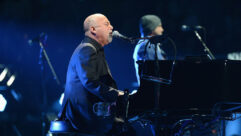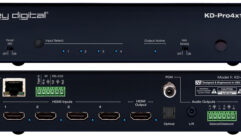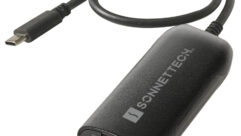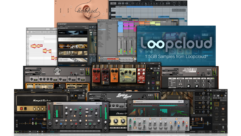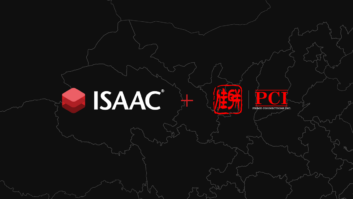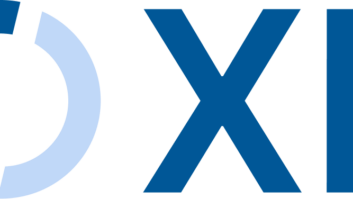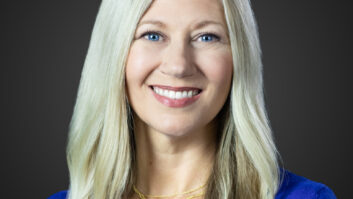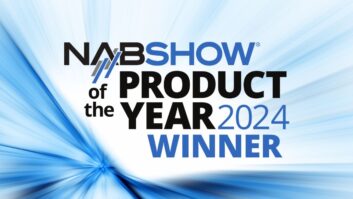
In this edition of the SVC Podcast, SVC Contributing Editor Bennett Liles continues his talk with Nic Dugger, owner of Tennessee Digital Television (TNDV) regarding the sound, video, IMAG and intercom systems set up for the National Quartet Convention, the biggest event in gospel music. Dugger provides more details on how TNDV connected the video screens, cameras, and routers to handle the technical feeds for the marathon show. He tells the tech story from setup to completion.
Links of interest:
- The Harris HView Multi-Display Management System
- The Harris Platinum Router used in TNDV’s remote trucks
- Hitachi HD5000 Cameras
- The RTS ADAM 160-port digital matrix intercom
Download Podcast Here:
https://s3.amazonaws.com/nb-svc/public/public/12_19_13-Nic-Dugger_TNDV_N…
Dec 19, 2013 10:22 AM,
With Bennett Liles
Listen to the Podcasts

Editor’s note: For your convenience, this transcription of the podcast includes timestamps. If you are listening to the podcast and reading its accompanying transcription, you can use the timestamps to jump to any part of the audio podcast by simply dragging the slider on the podcast to the time indicated in the transcription.
TNDV in Nashville is on the road the year-round with some of the biggest remote broadcasts in the business. Recently they were in Louisville, Ky., for the National Quartet Convention, the biggest gospel music show around. Nic Dugger is back to give us more behind-the-scenes looks at how TNDV pulls off this big show. That’s all right here on the SVC Podcast.
SVC: Nic Dugger, thanks for being back with us for part two on the SVC Podcast from TNDV, Tennessee Digital Television, in Nashville and we were talking about the National Quartet Convention in Louisville’s Freedom Hall. Lots of top gospel performers and TNDV was there for sound and video on it. You had Vibration, your new audio truck there. How did you set up having your own mix on everything?
Nic Dugger: I think the most important thing to note is the fact that we do take a full split—every audio input in use on the stage. We also take to the truck and in addition to that we also set up our own crowd microphone system just for effects mics. We typically end up having more inputs than the stage audio because we also want to supplement the sound with crowd noise, and we typically do that with shotgun mics strategically placed throughout the venue. This, in many cases, pushed our input count up to 50 or 60 or more inputs, which, you know, you think four or five or six folks on stage wouldn’t require that many inputs, but when you add a band and then you add crowd noise and crown effects mics to it, it’s very easy to get to 60 or more inputs. We split everything one-to-one with the truck. [Timestamp: 1:54]
And I guess it’s not just the crowd response you pick up on those but it’s really a certain amount of ambience that gives the whole show that live sound?
Very much so. The whole point of taking the Vibration audio truck to Louisville for this was to be able to monitor and mix in surround. And whether it’s 5.1 surround or 7.2 surround, those crowd mics are a huge part of what makes up that true like you’re sitting in the audience sound, so we take full advantage of that. [Timestamp: 2:21]
And you recorded all of this with the JoeCo BlackBox recorders that we talked about in part one. Are there any particular feature on those for you to bank so big a show on those things?
Sure. We actually have two recording devices. I think, you know, the industry-standard multi-track digital audio workstation would be Pro Tools, and we are avid Pro Tools users. We also use packages like Nuendo, but Pro Tools is what we use the most. The problem with Pro Tools—and it’s not a problem, it’s more of an opportunity—but it does run on a computer and computers tend to crash. So when you’re taking in up to 128 inputs per tower, and of course we have two of those to achieve the 256-input total that the truck can handle, there can be bugs. And occasionally RAM will have a problem, a hard drive might have an error, so we do everything redundantly. And what we back up our Pro Tools towers with is the JoeCo BlackBox MADI recorder, and we picked them for a number of reasons. Primarily they’re small. It’s only a 1RU infrastructure to put a JoeCo recorder in; of course we need four of these. Each JoeCo recorder does up to one MADI stream, and the MADI stream consisting of 64 inputs requires that we have four of those to achieve all 256 inputs, but they’re also extremely robust. One of the first shows we demonstrated the JoeCo’s capabilities on was a production we did in 2011 that required 24 hours of continuous recording. While Pro Tools managed to crash three times in that 24-hour period, the JoeCo was solid for the entire period and recorded all 64 inputs, all 24 hours, without a problem. That showed me that this is the kind of device that could stand up to the rigors of the road that we put these devices through, so we could easily record to the BlackBox recorder as our primary recorder and I would feel very comfortable with that. But to be safe, we do everything in duplicate, so it’s Pro Tools first, and then the BlackBox recorder second, but they do run simultaneously. [Timestamp: 4:20]
Well, I don’t feel quite so old school now because I record the podcast on two WAV recorders instead of a computer, for the same reason.
Just in case.
Dec 19, 2013 10:22 AM,
With Bennett Liles
Just in case. So what does the 256-input Studer Vista 9 console have that made it a good fit for the Vibration truck? That’s a big investment and the main feature of the new sound truck.
It is. It’s by far the main feature and I tell you, when you get into the kind of console level that the Studer Vista 9 is, they have everything. Really what’s more important to me, beyond the basic feature sets, are the familiarity of the audio-mixing community with that desk. What I did was I reached out to a number of lead audio engineers and I said, “If you had all the money in the world, what desk would you pick for your primary desk?” I’m the first to admit they didn’t all list the Vista as their first choice, but I tell you, it was in every single audio engineer’s top three. Many of them did mention it first. And the fact that it’s familiar to the audio-mixing community is a huge plus, because if the freelance teams don’t buy off on it, it’s not worth the money to me. A second very big reason I picked it was the fact that I grew up using Studer hardware. We had Studer consoles at the college I attended, and the fact that 15 or 20 years ago that was the first choice, means to me that they have the staying power, that they’re going to be in business for a long time, and I can expect support from them. The other reason was our other three HD video trucks with audio suites all feature consoles that are also manufactured by the Harman line, so the parts are interchangeable. I feel very comfortable saying that every TV truck that we have in Nashville has a desk manufactured by the Harman Corp. On top of that, it comes down to usability. You know, the Studer desk has taken into account what the user experience is mixing. You know, when you have a desk that’s 8ft. long, simple things like the fact that you can color-code your channel strips with LED lighting, and you can group your channel strips with their Vista fader glow technology, it seems like a small detail, but when you’re working in this truck for hours and hours on end, it’s some of the ergonomic things that stand out. The fact that the desk was built for a user to sit and work for four or five or six hours in a row without a break tells me that they really put the user in mind. Does it sound good? Yes. Does the EQ in realtime waveform display impress me? Absolutely. But those are features I would expect on any console at this level. What I’m looking for is what Studer does above and beyond the other desks, and that was the features as well. [Timestamp: 6:57]
And those very useful features don’t come from guys in lab coats at the company. Those come from the guys out there on the road and it says something good about Studer when they listen to the actual operators and incorporate their ideas.
One of my favorite stories is we had the Final Four basketball tournament was in Atlanta this past year, and luckily one of our trucks was able to go and provide facilities for that show. One of the featured performers was Sting. You know, Sting is a pretty well-known performer who can pretty much have his choice of whatever hardware he wants. So I went to the front-of-house position to meet with Sting’s touring engineer, and he had a Vista. His was the Studer Vista 5. And I complimented him on the desk and I said I thought it looked like a real robust piece of gear, and I could tell he had a bit of an attitude about his Studer. He said, “Yeah, it’s a very high-end piece of equipment.” I said, “Yeah, it’s cute. I thought about the Vista 5, but I went ahead and got the big one. You know, we own a Vista 9. I’d love to show it to you.” And the look on his face, I don’t think he was prepared for the 34-year-old kid to one-up him with a console much larger than his, but I think I earned a certain level of respect from Sting’s front-of-house engineer when he found out that we had the console that was even fancier than his. [Timestamp: 8:09]
Well, you run into that in a lot of places and you really get around with those trucks and you have to coordinate a lot of people. How many people do you have on the whole crew for this particular event?
You know, the TNDV staff, our full-time engineers, we have 16 members in Nashville, but we would be nothing without our network of freelance support staff, and of course there’s hundreds of those folks around the country. But for the NQC show, our team leader was Russ Hall, who was the director and producer, and Russ is an outstanding leader not only in assembling the crew but in communicating effectively on the show side of what he wants out of that crew. In the truck, on average there are about 10 folks in the video truck and about three folks in the audio truck, plus your camera operators on top of that. It’s not unusual to have between 20 and 25 people on the video crew at all times, not to mention the additional support staff in the building that’s just there to help the video team. [There was] a team the size of about 25 folks on average for the days of the NQC conference. [Timestamp: 9:12]
And that’s a lot of people who have to be able to communicate effectively and not have it turn into the Tower of Babel. How did you have the channel assignment laid out? You had camera people and recording people?
We did. You know, we’re very proud of our intercom infrastructure. I think it’s a basic requirement that a video truck has a robust intercom, but in addition to that, our Vibration audio truck also has an 80-port matrix intercom system from RTS. Our audio truck has a bigger intercom system than many video trucks. What that allows us to do is build party-line infrastructure. We typically have six party lines that anybody can jump on, and that’s so that the cameras can have their own channel. Audio, lighting, stage, producers, all these people can have their own channels and then we typically also build an engineering channel for any problems with gear or technical issues, and that’s, again, all the party-line channels. In addition to that, because it’s a matrix channel, we can also have what we refer to as point-to-point channels. If I want the director to be able to talk only to a producer and nobody else can hear, I can build custom point-to-point channels infinitely between these user stations, and in this case, between the two trucks. Six party-line channels plus another 20 or 30 point-to-point matrix channels gave us an intercom infrastructure that let us speak to everybody, or nobody, depending. We can be very selective about the groups or individuals we want to talk to from each individual user station. [Timestamp: 10:41]
And a lot of thought and planning has to go into who can talk to which people and who should not have to hear various things. The same thing goes with the routing of the video and sound, and I think you use the Harris Platinum routing system on the truck.
We do. All of our video routing and all of our multi-viewers, the single-screen versions of multiple cameras, is provided by the Harris Platinum router. We also have the HView multi-viewer option. What that does is allow us to route to things like our video-record machine to our house feed so we can route the web feed independently of the screens feed, any monitors within the truck—you know, the monitors at the producer’s desk, the monitors on the monitor wall, everything is fed by that Harris router and it allows us to create quick and easy routable destinations that can change on the fly. [Timestamp: 11:28]
And you’re doing so many different video feeds. I think the last time we talked about your cameras I believe you were mentioning the multiple the tallies on them.
They have not only multiple tallies to let the camera operators know when they’re either on the screens or on the broadcast feed, but they also have multiple return inputs. If we need to feed a camera operator program in one return and maybe the football game, if they want to keep up with the score, in return two, our cameras actually have the ability to take up to eight different return video signals back from the truck. [Timestamp: 11:57]
And all of that is one big machine to get going. Once you have all that stuff connected how long does it take to fax everything out and be ready for rehearsals?
It actually doesn’t take long, because what we’ve done is we’ve gone to great expense to get the truck wired so that when it parks and powers up on a show site, other than setting up the camera physically, it’s ready to go. All this infrastructure is wired and tested and really never changes. We just have to make sure that everything works per location. As you pointed out, we do a facilities check and that typically takes about an hour to go camera to camera and test all the different features, but it’s because it’s all wired up and pre-tested before we ever show up on site. [Timestamp: 12:34]
Well, I know big shows like that are fun but you’re going full speed all the time. Thanks for giving us the behind the scenes look at that one, Nic. What’s coming up next for TNDV?
Toward the end of the year is just when it starts getting good for us because this is the start of awards season. We’ll be producing the Dove Awards for the Gospel Music Channel. We’ll be providing facilities for the CMA Awards in Nashville. We’ll be doing the red carpet special for the Great American Country Network. We’ll also be doing live web streaming for the CMA organization itself. We have the Nashville Songwriters’ Association Awards coming up, and we’re already in early preproduction for the Midsouth Regional Emmy Awards, which is a live television awards show that we produce for people in the television industry with one of our HD trucks. So still lots cooking for the end of 2013. [Timestamp: 13:21]
Okay. No time to calm down from the National Quartet Convention before you’re back on the road and right into the next remote. Nic, thanks for telling us about this one and you guys keep up the good work.
Thanks very much. I appreciate you calling.


